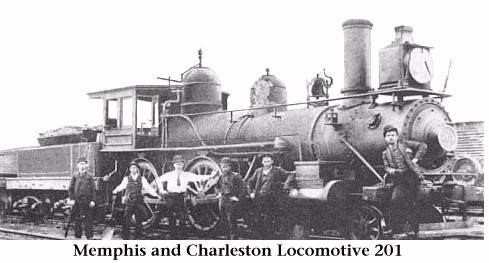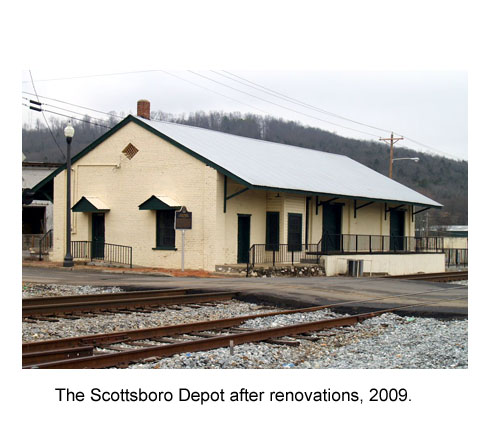Building the Scottsboro Depot
The Memphis & Charleston (M&C) Scottsboro Freight Depot, located at the junction of North Houston Street and Maple Avenue, is one of early Scottsboro's oldest surviving landmarks and was the vital center of Scottsboro’s first business district.
When the depot was built in 1859-61, it was considered a revolutionary idea. Only a small group of people envisioned a need for its existence. Although this was not the first freight depot in Jackson County, it was the first brick building in the small railroad town of Scott’s Mill. The new depot had no electricity, no running water, no telephone or telegraph system, and required only one man to dispense the services it provided.
The depot was less than a year old when the Civil War began, elevating the railroad's importance in the community, the state, and the nation. Before that war ended, men fought in armed combat to control the freight depot and its access to the rails. Musket ball holes found in the walls of the depot are silent, enduring testimony to the blood skirmishes fought in and around the depot.
To better understand the impact of the Memphis and Charleston Railroad, one must first look at snapshots of this area before the “ironhorse” entered its maiden race across Jackson County. The Memphis and Charleston Railroad Company (M&C) was chartered through Alabama in 1850. By 1855, one could travel by train from Memphis, Tennessee, to Huntsville, Alabama. The next spring the track was completed into Stevenson, AL, which became the eastern terminus for the M&C. The M&C sold stock to finance its tracks, and several men in Jackson County purchased shares in the company.

The Memphis and Charleston Railroad was completed in 1857, was the first railroad in the United States to link the Atlantic Ocean with the Mississippi River. Chartered in 1846 the railroad ran from Memphis, Tennessee to Stevenson, Alabama through the towns of Corinth, Mississippi and Huntsville, Alabama. In Alabama, the railroad followed the route of the Decatur-Courtland-Tuscumbia Railroad between, Tuscumbia and Decatur, the first railroad to be built west of the Appalachian Mountains. (FN to Wikipedia)
To celebrate the completion of the eastern section of the tracks, the M&C offered an excursion ride from Huntsville to Stevenson and return for all stockholders. The 300 passengers made the sixty mile trip in four hours. A newspaper reported noted:
“Stevenson is THE town of Jackson County. It is only four or five years old, and already it contains a number of very pretty private residences, three hotels, and several large wholesale and retail houses which are doing a thriving business.”
Although 35 years old by 1856, Larkinsville was not mentioned in this newspaper article even though it was Jackson County’s largest town at that time. In 1856, five years before the Scottsboro depot, a brick freight house was built by the M&C in Larkinsville and a wooden freight office with a ticket window was found in Woodville.
In 1856, Scott’s Mill, the town that would become Scottsboro, was still in its infancy. With the M&C as the active midwife, Robert T. and Elizabeth Ann Scott gave birth to their namesake in 1854 or 1855. Most likely Scott’s Mill was only a M&C water station until the Scottsboro brick freight house (which included a ticket office) was completed in 1861.

The original depot buildings at Woodville, Larkinsville, and Bellefonte Station (later called Hollywood), were all destroyed during the Civil War, but the Scotttsboro depot miraculously survived. It was repaired in 1866 and was remodeled in 1885, according to M&C records. The 1895 M&C minutes recorded: “The Scottsboro Freight Depot needs repairs and painting.”
For many years the M&C freight depot defined Scottsboro’s city limits: at the time of incorporation in 1868, the corporate limits extended one-half mile, in all directions, from the freight depot. This means the northern limit was near Poplar Avenue, the southern border was near College Avenue, the eastern edge was Kyle Street, and the western border fell along present-day Cedar Hill Drive. The first business district was located on either side of the railroad tracks (between present-day Mountain Street and Broad Street.) Cows sometimes roamed the dirt streets, and strays were tied to the rope which rang the town bell to announce their errant ways. (Source: Elizabeth Snodgrass)
Railroad mail and passenger service in Jackson County ended in the 1960s, but freight traffic continues to grow. CSX Transportation, successor to L&N. retains an office in Bridgeport.
Norfolk Southern Railway, formed from the 1982 Southern/Norfolk & Western merger, transferred ownership of the antebellum Scottsboro freight depot to the city. Scottsboro's former passenger station was removed from downtown several years ago and stands in a local resident's yard.
From the time it was built until it was decomissioned in 1991, the depot survived, never "missing a day's work" in the 132 years of its existence. It was placed on the National Register of Historic Places on February 20, 1998.